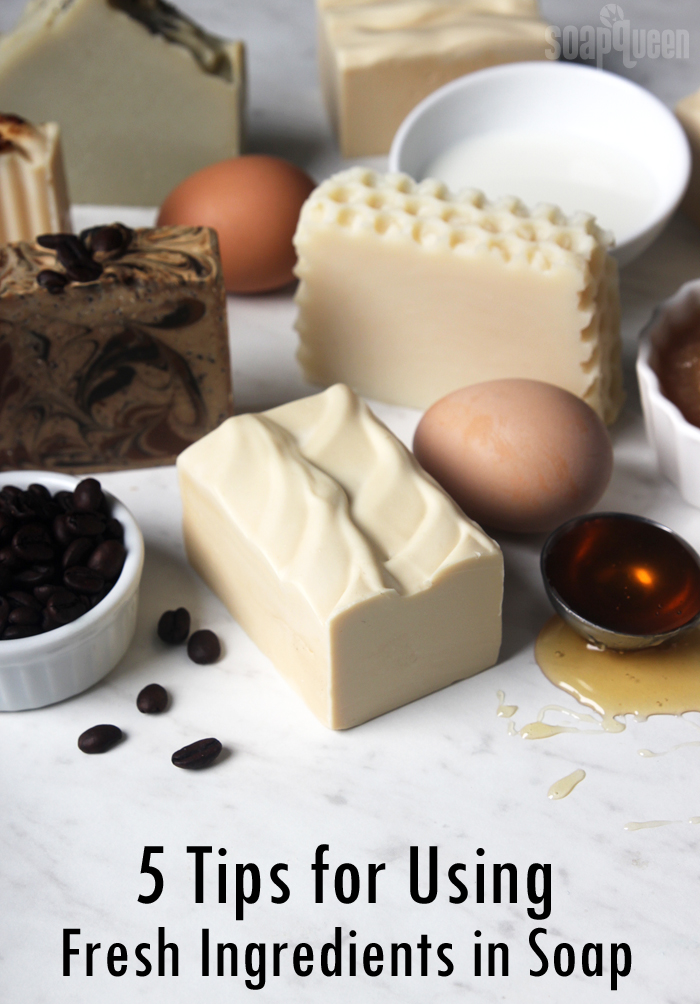
Have you ever looked in your kitchen cabinets and thought, “Huh, I wonder if I can put that in soap?” If so, you’re in good company. It’s a pretty common thought among soapmakers. Also, you are in luck – there are plenty of fresh ingredients you can use in your cold process recipes. In addition to setting your soap apart and attracting customers, fresh ingredients add something special to your recipes. For instance, avocado gives soap a luxurious feeling. Find a roundup of recipes made with fresh ingredients here. Before getting started, there are a few things to know. The tips below will ensure your experiments turn out well so you can focus on the fun part – getting creative and trying something new!
Research Before Getting Started
Each ingredient you add to your recipe will affect how the soap performs. If you add an ingredient with natural sugar, it can cause acceleration and overheating. If you add an ingredient with a lot of liquid, it can make your batch too wet. That’s why research is important. Find out how the ingredient performs beforehand so you know what to expect and can account for any quirks. The How to Add Purees to Cold Process Soap has plenty of information to help get you started.
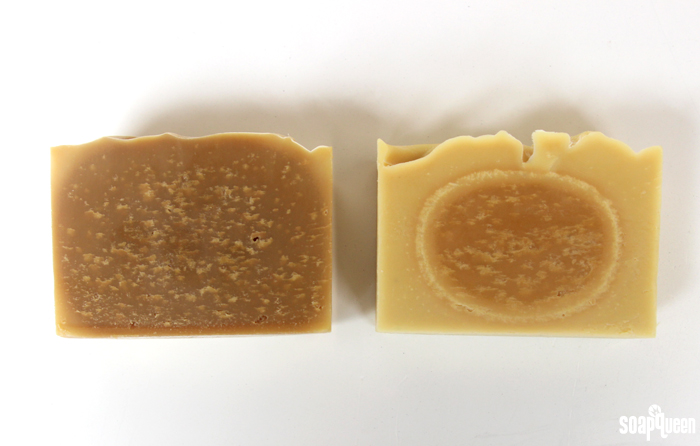 Honey can overheat in soap and cause discoloration and bubbles, as seen in the photo above. Learn how to work with honey here.
Honey can overheat in soap and cause discoloration and bubbles, as seen in the photo above. Learn how to work with honey here.
Buy Local
Once you decide what ingredient you want to experiment with, the next step is finding it. We recommend buying local! There are so many quality ingredients at your local stores and farmers markets. For instance, at the Farmers Market here in Bellingham, there is everything from fresh coffee to juicy blueberries. They would be an amazing addition to your recipe. Not only do you support your local economy, but you can tell your customers all about the fresh ingredients and where they come from. It’s an amazing selling point and it shows off your hometown pride.
Consider a Water Discount
To help the fresh ingredients mix in smoothly, they are often pureed with distilled water. Many fresh ingredients also contain a lot of liquid. The added water can make your soap too wet. That’s where a water discount comes in – it accounts for the extra liquid you’re adding to your batch. It also helps prevent glycerin rivers. How much water you discount from your recipe depends on the fresh ingredient. For instance, cucumber is a very watery vegetable, so a higher water discount would be helpful. A good water discount to start with is 10% and adjust from there based on the additive you choose. Learn more in the Water Discounting Cold Process Soap post.
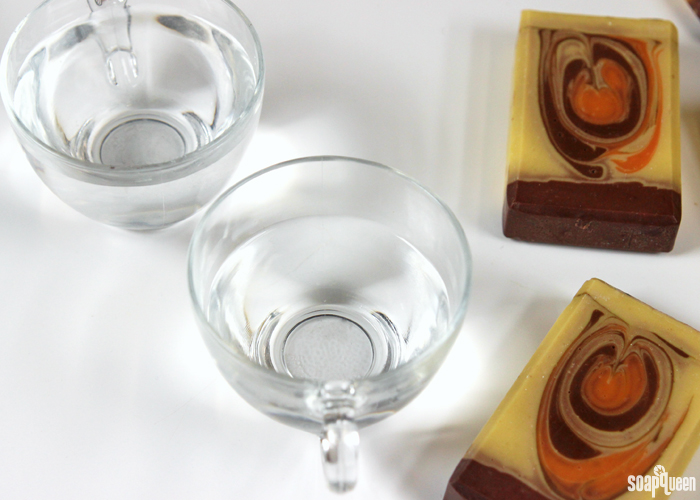 A water discount keeps your recipe balanced.
A water discount keeps your recipe balanced.
Watch Those Temperatures
Fresh ingredients with natural sugar have the potential to overheat in cold process soap. That can cause discoloration, an unpleasant smell, heat tunnels and, worst case scenario, a soap volcano. That’s why it’s important to keep your temperatures low. Soaping around 100-110 ° F will keep things cool and give you time to work with your design. If you’re using an alternative liquid, you may want to cool or freeze it beforehand to prevent scorching. Learn more about working with coffee and tea, alcohol and milk in your soap. Once the soap is in the mold, put it in the fridge or freezer for 5-24 hours. If you’re using a fresh ingredient without natural sugar, they can still cause glycerin rivers or partial gel phase. You can leave the soap at room temperature or cool it in the freezer to be extra careful.
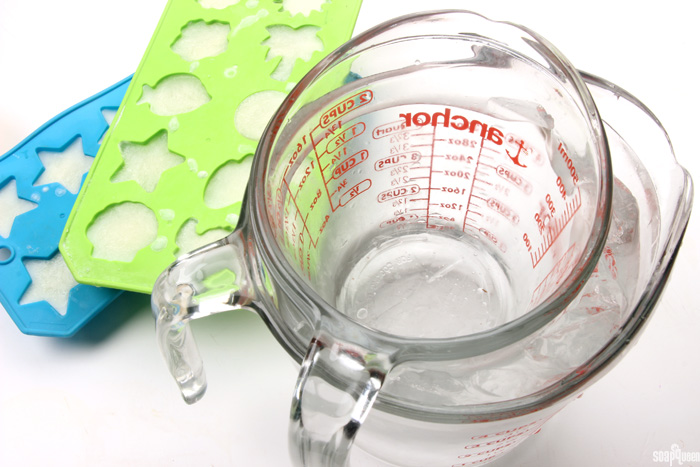 Milk needs to be frozen before the lye is added to keep temperatures low. Learn more in this post.
Milk needs to be frozen before the lye is added to keep temperatures low. Learn more in this post.
Test it Out
Whatever fresh ingredient you choose to jazz up your cold process soap, make a small test batch of your recipe. If you’ve never worked with that ingredient before it can do unpredictable things. The test batch allows you to make adjustments before making a larger batch. It’s also a great time to test the bars on your skin to see what you think. If you add avocado and the bars are too soft, you can add more hard oils like coconut and palm. If the honey overheated your batch even with cooler temperatures, you can add less next time. Before you know it, you’ll be a pro at adding random cabinet ingredients to your handmade goodies!
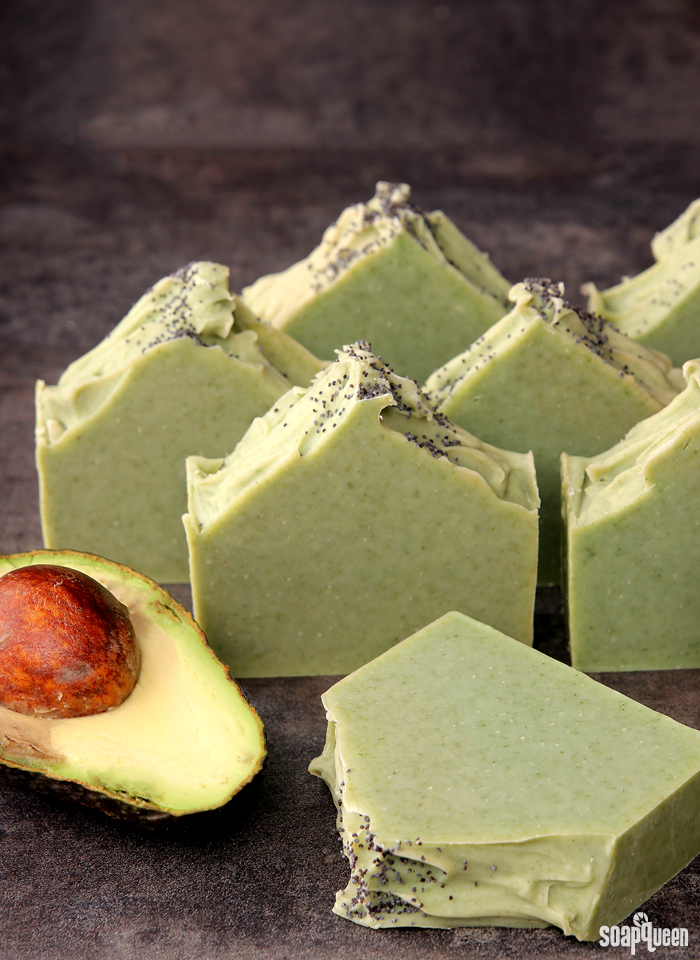 The Avocado + Spearmint Cold Process Soap took several tries to get just right.
The Avocado + Spearmint Cold Process Soap took several tries to get just right.
What’s your favorite fresh additive for cold process soap?




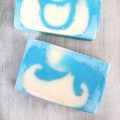
I’m getting ready to dip my toe into soap making and I’m starting out with melt and pour.I’d like to make a milk & honey soap to start with and was wondering if I can use powdered milk instead of regular milk so as not to worry about spoilage.
We don’t recommend using any milk products in melt and pour.
Hi, I would like to ask if it is okay to use Kefir Fruit in CP? and how to use it?
Thank you
We haven’t tried using kefir in CP, but since it’s made with milk and/or fruit then it’s going to have quite a bit of extra sugar in it. Keeping an eye on your temperatures is going to be key, and you may want to follow the instructions on adding lye to milk found here: https://www.soapqueen.com/bath-and-body-tutorials/tips-and-tricks/how-to-add-lye-to-milk-for-cold-process-soap/ We would recommend trying a small test batch first just to make sure you like the results.
Hi,
Thank you so much for your answer. How about adding fresh elemi? A friend told me that I should infuse it with oil and let it sit for 1-2 weeks? Is that correct?
We have not worked with fresh elemi before so I’m not 100% sure. If you’re making an oil infusion with it that should work though. I would recommend a small test batch to make sure you like the results.
How to Infuse Oils with a Crock-Pot: https://www.soapqueen.com/bath-and-body-tutorials/tips-and-tricks/how-to-infuse-oils-with-a-crock-pot/
Hi – Thank you so much.
I did my very first cold process soaps earlier; shampoo bars. I followed recommended usage for each oils that I used in the recipe yet it seems a disaster. The soap won’t trace.
Here’s my recipe (for your reference)
for 500 grams of oils
Sweet Almond Oil – 25% (also followed the maximum recommended usage which is 25%)
Rice Bran – 40% (because I read from several articles that it can be used up to 100% just like olive oil)
Cocoa Butter – 15% (also followed the maximum recommended usage)
Coconut Oil – 20% (this one, a friend told me that coconut oil can be used up to 30% but can cause a drying effect.)
First, I melted the cocoa butter in a low heat the add the liquid oils.
I mixed the lye water (105 F) and oils (115 F) then mix it for 20 minutes (manually) then mixed it with stick blender (but during this mixing – the mixture started producing bubbles and won’ trace)
I mixed it again manually for 30 minutes – still won’t trace. Then, I just let it sit and mix the essential oils, citric acid, and the vitamin e even without the trace and put it in the 6 cavity silicone molds and been hours still liquid.
Can you help me know what might be the cause why the batch seemed to be a disaster? (really felt like one since I did everything I could to reach the trace but failed)
Is my recipe wrong (combination oils?) or is the temperature when I mixed the lye water and oils is incorrect? I am planning to revise my recipes. What can you suggest?
Lastly, how to make sure I put the soaps in the molds evenly since its a cavity silicone molds? (I know this may sound like a stupid question but I am really worried that I did not put it evenly.)
Thank you so much!
Hi Jessica, while hand mixing your soaps to trace it can take hours. I am not sure why it wouldn’t have traced eventually unless you were using the incorrect lye amount or using the wrong type of lye. If you have further questions feel free to contact us at [email protected].
I was reading your note about the soap not coming to trace. You said that you added citric acid to your soap. Citric acid is a strong acid, and lye is a strong alkali; the two will cancel each other out, and you will not have enough lye to saponify your oils. Ask me how I know this!! Did your soap batter turn a weird shade of orange? When I made my experimental batch, I used lemon zest, and it was enough to throw off the balance.
If you want to test the pH, to see if your lye is still working, the pH test strips are available just about anywhere you would buy supplies for pools, hot tubs, hydroponics, etc.
Hello!
I have been wondering whether I can use pumpkin puree instead of water when mixing with NaOH and not use the puree at trace.
I have made myself the puree without using any water, so, maybe it is better if I add some water along with the pumpkin puree? For example if a recipe calls for 300 g water, I am thinking of using 200 g of pumpkin puree and 100 g of distilled water.
How does sound to you?
Thank you,
Nafsi
I’m not sure, when we work with pumpkin we add it at trace. My worry is that the lye would scorch the natural sugars in the pumpkin and the mixture may also be thick and hard to work with. You may want to make a small test batch first to see how it goes.
You can freeze the pumpkin ahead of time like we recommend with milk: http://www.soapqueen.com/bath-and-body-tutorials/tips-and-tricks/how-to-add-lye-to-milk-for-cold-process-soap/
I will try a small batch with frozen pumpkin and let you know.
Thank you very much :):)
how about mango?
We haven’t tried mango in soap, but you can follow the guidelines listed above. Keep your temperatures low and make a small test batch to see how it performs in soap.
i live in the caribbean and use many local ingredients including mango. I used 40 grams in a 24 ounce batch and it was too much, I am going to try 20 grams next time. We have a local herb called bija. I think it is called annetto in the states, I soak some in my soaping oil for a day to get a nice mango color
Thanks for the tips TJ, I think that will be really helpful for others wanting to try mango.
Does this apply to liquid castile soap making?
-Thank You
Yes, this does apply to liquid soap made from scratch. However, because liquid soap requires such a long cooking time, the fresh ingredients may scorch and discolor. You can make a small test batch to see what you think.
If you’re diluting a premade liquid soap base, we don’t recommend adding fresh ingredients. The base is already made, so the fresh ingredients will shorten the shelf life to just a few weeks.
Learn more about working with premade bases here: https://www.soapqueen.com/bath-and-body-tutorials/tips-and-tricks/how-to-use-and-thicken-liquid-soap-base/
I’m just beginnng with cp soaps. As I live on an island in the SW Pacific, I have limited access to a lot of the ingredients you talk about and I would like to specialise in local products. One thing I have is coconuts. I would like to use fresh coconut milk in a future soap. I use an Omega juicer to extract the milk from the coconut flesh and this makes a very thick and creamy milk. However, all of the recipes I can fnd use canned coconut milk. Do you think that I can use it in the same way or do you have any other suggestions. Thank you for all of this wonderful information. I don’t know what I would do without it.
You can definitely use fresh coconut milk for your soap, that will feel nice and creamy in the final bars. You’ll want to use it just like canned milk, which means keeping the temperatures low and putting the soap in the freezer to prevent scorching. Learn more here: http://www.soapqueen.com/bath-and-body-tutorials/tips-and-tricks/how-to-add-lye-to-milk-for-cold-process-soap/
It may also help to make a small test batch to see how the fresh coconut milk does in your soap. That way you know what to expect for a larger batch.
-Kelsey with Bramble Berry
Hi. I was wondering about using goat milk for cold process soap. I normally weigh the liquids on my scale, but I watched Anne Marie’s video on using goat milk and she said to weigh by volume rather than weight. Is this standard for goat milk, all milk, or at all? I own two of her soaping books and neither says to weigh milk recipes by volume. Thanks!
We have tried both methods and since then we’ve found that weight is a bit more accurate, so we recommend using weight over volume. 🙂
Learn more about working with milk here: http://www.soapqueen.com/bath-and-body-tutorials/tips-and-tricks/how-to-add-lye-to-milk-for-cold-process-soap/
-Kelsey with Bramble Berry
Dragonfruit in soap?
We haven’t given that a try, so I’m not entirely sure how it works. You can try a small test batch using the tips shared above. 🙂
-Kelsey with Bramble Berry
I’ve tried using dragonfruit puree in soap as I was curious if that beautiful colour would survive the process. It didn’t! But it made a nice soap, with the seeds giving it a mild exfoliating effect.
I have actively been soaping now for 3 months and just venturing into fresh additives. I have seen vegetable powders and purées used but what about juiced veggies as a %. Would the pulp cause any spoilage or DOS?
Pulps won’t spoil because the saponification process turns them into soap. However, they can turn brown in cold process soap, as can the powder and juice. It depends on the vegetables and fruits you add. For instance, we found carrot creates a nice orange (that does fade), while strawberries turned brown: https://www.soapqueen.com/bath-and-body-tutorials/cold-process-soap/strawberries-cream-soap-a-cold-process-tutorial/
-Kelsey with Bramble Berry
Hi Kelsey.
I was thinking of making a lime tea using fresh lime peel. Using this tea as the liquid in my CP soap, not for color but the lime scent. I wonder if you have any thoughts on this? Do you think the scent will fade? Will the acid in the lime react negatively with the lye? Will I have to worry about the soap overheating if I’m just using the peel and not the pulp?
Thanks
I wouldn’t recommend lime tea. Because of the lime pH, it can react with the soap and do weird things in your batch. The scent will also be very light. If you want a nice lime scent, this fragrance oil will work nicely: https://www.brambleberry.com/Lime-Fragrance-Oil-P3939.aspx
Find out how much to add to your batch with our Fragrance Calculator: https://www.brambleberry.com/Pages/Fragrance-Calculator.aspx
-Kelsey with Bramble Berry
Hi, thumbs up for all your hardwork and selflessness. Am Stephany from Nigeria, wondering the list of ingredients, whether oils or fresh ingredients that helps to lighten up the skin.
We don’t have any ingredients that are proven to lighten the skin. The ingredients above do have some great benefits though, like moisturizing the skin or coloring the soap.
-Kelsey with Bramble Berry
I would like some advice on adding powdered cinnamon in a CP soap recipe. I have some cinnamon basil growing in my garden and though it would make a good kitchen soap. I infused some of the leaves in rice bran oil. However, the natural cinnamon scent, which is normally very subtle kinda disappeared and now only smells like basil. I’m thinking of adding the ground cinnamon (from the kitchen cabinet) to boost the scent, but also as a colored swirl. What would you suggest?
For some people, cinnamon can irritate the skin. To be on the safe side we don’t recommend adding cinnamon to soap. Also, the cinnamon itself won’t add a lot of scent to your bars. Instead, you can use cinnamon essential oil: https://www.brambleberry.com/Cinnamon-Leaf-Essential-Oil-P3641.aspx
Or a fragrance like Cinnamon Sticks: https://www.brambleberry.com/Cinnamon-Sticks-Fragrance-Oil-P6306.aspx
Cinnamon Sugar Fragrance Oil: https://www.brambleberry.com/Cinnamon-Sugar-Fragrance-Oil-P3644.aspx
Find out how much to add to your recipe with our Fragrance Calculator: https://www.brambleberry.com/Pages/Fragrance-Calculator.aspx
-Kelsey with Bramble Berry
Hi. I love your blog and i have learnt everything about soap making from here. I live in India. The temperature here reaches up to 100F and humidity aroun 55percent! I want to add fresh aloe Vera in my soap using cold process. I have following queries:
1. Do you think i should keep the moulds in refrigerator for few hours? 2. After unmoulding, how should i store my soaps for curing?
Thanks a lot.
If you want to keep your soap cool, you can definitely keep it in the fridge or freezer for 5-24 hours. That will prevent overheating. Once the soaps are unmolded and curing, you’ll want to keep them in a cool, dry place. If you have a cool basement or garage that will work! If not, you can use a dehumidifer or run a fan over the soaps as they cure. 🙂
Learn more about storing soap here: http://www.soapqueen.com/bath-and-body-tutorials/tips-and-tricks/how-to-store-handmade-bath-products/
-Kelsey with Bramble Berry
I love adding fresh fruit and vegetables to my soaps, it always adds extra properties, fresh egg in my hair soap adds extra foam and bubbles
Absolutely, each one adds something special! 🙂
-Kelsey with Bramble Berry
I just tried an egg hair soap last night. The bars are curing now. Mind if I pick your brain and ask what you SF your bars at? So far I’ve been doing 10% with 2 other shampoo bars 1 of I was not thrilled wit as I feel did not rinse well.
We like to superfat at 5%. We find that adds some luxury without making the bars too soft.
Learn more about superfat here: http://www.soapqueen.com/bath-and-body-tutorials/cold-process-soap/superfatting-soap-an-explanation-2/
-Kelsey with Bramble Berry
I know this isn’t a ‘fresh’ ingredient, but wondered if anyone knew what would happen if jellied cranberry sauce was used in place of a puree. I figured the sugar would boost lather, but what else?
Jellied cranberry sauce may be tricky. It will have a lot of sugar in it, as well as a thickener like gelatin that can do weird things in soap. Instead, you may want to try a low-sugar cranberry juice or unsweetened cranberry. I would recommend a small test batch. If using the juice with sugar, make sure to soap at low temperatures and put the mold in the fridge or freezer afterward to keep it cool!
You can add castor oil at 2-5% to help boost lather as well. 🙂
Castor oil: https://www.soapqueen.com/bath-and-body-tutorials/tips-and-tricks/sunday-night-spotlight-castor-oil/
-Kelsey with Bramble Berry
Thanks! I may try it, and was thinking about possibly liquefying it first, maybe by adding water, or something else? I guess I’m game to experiment.
Here are the ingredients: Cranberries, high fructose corn syrup, water, corn syrup, citric acid. I think the citric acid would be an issue. What if it was added in at trace? I like using honey (beeswax too) in my soaps, and that typically accelerates trace.
If I don’t do a coconut oil soap, I will use castor oil, so that’s a good reminder. Success or fail, if I try it, you’ll be sure to hear of it. 🙂
Usually the citric acid is used at such a small amount it should be fine! You may try mixing a bit with distilled water and adding about 1 teaspoon per pound of soap at trace, much like you do with honey. Then, pop it in the freezer for 24 hours to keep it cool and prevent overheating. A small test batch will definitely help to see how it works in soap!
Learn more about working with honey here: https://www.soapqueen.com/bath-and-body-tutorials/tips-and-tricks/adding-honey-to-cold-process-soap-tips-tricks-recipe/
-Kelsey with Bramble Berry
Thanks for the tip! I’ll just have to experiment, and then post my comments later.
Is there a way to share photos? I did get a reply to my email, and was wondering if that’s how I could send something to you.
You can share them on our Facebook page! They can be shared in a private message or on our wall: https://www.facebook.com/BrambleBerry/
-Kelsey with Bramble Berry
Kelsey,
I know it’s been a while since I asked you the question about adding jellied cranberry sauce, but I finally did a batch the other night, and here’s what happened:
I used a 1-1-1 (approximately, because I didn’t weigh anything) of jellied cranberry sauce, coconut milk (it had additives too), and cows’ milk. I blended them up real good, and just for the heck of it, added some food coloring just to see what would happen. I put this mixture in a ziplock bag, then froze it.
I decided to only use coconut oil (20% superfat), since it was the quickest to do, and I could make a real small batch. I had NO problems with it going to trace, and I put in a soap safe cranberry-pomegranate fragrance I got from someone. The color didn’t stay, and it is more of a yellowish beige, just like usual milk soaps. It’s out of the molds, so I won’t know what happens with performance until I test it out in about a week.
I wanted to share my results. 🙂
Oh that’s awesome, thanks so much for sharing! I imagine it’ll feel nice and creamy and have great lather from the added sugar.
-Kelsey with Bramble Berry
Hi again Kelsey,
Just another update. I couldn’t resist waiting, so I tried out that soap last night. It lathers just fine, and is no different from any other soap I’ve made (currently, I only do CP). A big reason I like using coconut oil only, is because it hardens quickly, and stays that way.
Another thing, I went and re-read one of your initial replies. I did not place the molds in the freezer, or any other cold place to keep it cool. Without looking at my notes, I think cranberry sauce/milk/coconut milk mixture was under 100 degrees, and the coconut oil was around 110 degrees. It behaved like any other batch.
Nice, sounds like you learned some good things from your experiment. 🙂
-Kelsey with Bramble Berry
Hi! I started to make a batch of soap tonight using oatmeal milk (water) for the required amount of water. When I added the lye to it, it turned really thick and globby. In a panic and not wanting to ruin all of the oils, I poured it into a mason jar, and re-made the lye water. More research – I found I should have frozen the oatmeal water first, and that it was ok to turn thick & globby – it would have stick blended out smoothly.
What I need to know – what can be done with the globby oatmeal lye water now? If it is to be disposed of, what is a safe way to discard it?
Thanks so much!
I would recommend trying to use it! The chunks in there may be saponified bits of fat, or thickener that has clumped up. You can put it in your oils and stick blend for a good minute or two to try and get those clumps worked out. You may want to use a more simple recipe to account for the thicker trace. You can even make a small test with it to make sure everything goes well before making a larger one. 🙂
-Kelsey with Bramble Berry
Thank you so much for such a quick reply! I’ll give it a go!
Wondering if adding these kind of Ingredients, will it cause tracing fast and orange spots after 2 months?
It depends on the fresh ingredient. Ingredients that contain natural sugar like honey can speed up trace. What ingredient are you wanting to incorporate? Let me know and I can offer some tips for working with it. 🙂
Also, when you add fresh ingredients to your recipe, they turn into soap. That means they are now soap and will have the same shelf life as your bar. However, using old oils or tap water can cause those spots. They’re called Dreaded Orange Spots. Read more about them here: https://www.soapqueen.com/bath-and-body-tutorials/tips-and-tricks/dreaded-orange-spots/
And read more about the shelf life of your soap here: https://www.soapqueen.com/bath-and-body-tutorials/tips-and-tricks/shelf-life-bath-products-ingredients-rancidity-vs-mold/
-Kelsey with Bramble Berry
I always love your advice and I’m actually taking some as I write. I’m experimenting with tamanu oil and applejack peel fragrance oil. The small batch of oil is cooling now because I researched and took Brambleberry’s suggestion on the fragrance oil and I’m doing a very small batch for myself only. Thanks for all your posts and I can’t wait to try the small batch of soap I know will be amazing!
You’re welcome Eric! Let us know how the small batch turns out. 🙂
-Kelsey with Bramble Berry